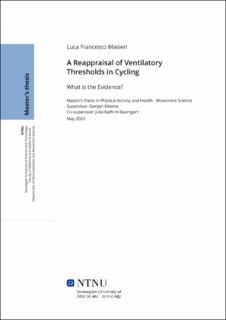| dc.description.abstract | ABSTRACT
Background:
Intensity zones are commonly used to individualize training programs. These zones are often based on ventilatory thresholds (VTs) retrieved from graded exercise testing (GXT) protocols. The VT1 separates low and moderate intensity, and the VT2 moderate from high intensity. The methods used to detect the VT1 and VT2, a priori, assume the presence of a distinct “breakpoint”, where the physiological response changes markedly – however, it is not clear whether these breakpoints actually exist.
Objectives:
The objectives were: (1) compare the fit of a continuous (no-breakpoint) function with a discontinuous (breakpoint) function, used to identify VTs, (2) evaluate the test-retest reliability of thresholds identified during repeated GXT, (3) appraise the relative impact that two different GXT protocol have on the determination of VTs.
Methods:
For primary data, n=19 participants, performed two different GXT (i.e., RAMPOwn, GRADEDOwn). For secondary data, retrieved from a published study, (Pallarés et al., 2016), n=14 participants performed two identical GXT (RAMP) protocols, (i.e., TESTPallarés, RETESTPallarés). A function with two regression lines were fitted to the oxygen uptake (V̇O2)-carbon dioxide production (V̇CO2) data, to identify VT1, and to the V̇CO2-minute ventilation (V̇E) to identify VT2. The same data were also fitted by an exponential function. Wilcoxon signed rank tests were used to compare the R2 outcome parameters of these functions. ICC analysis for test-retest reliability was performed. In addition, the Bland–Altman analysis assessed the differences between TESTPallarés -RETESTPallarés and RAMPOwn-GRADEDOwn at VT1 and VT2.
Results:
At VT1, only for GRADEDOwn a significantly better fit for the discontinuous function (breakpoint) (p < 0.01) was found. However, these differences are relatively small. At VT2 no significant difference in fit between the continuous function (no breakpoint) and the discontinuous function (breakpoint). A comparison of the test-retest reliability (TESTPallarés, RETESTPallarés) revealed no significant difference (p > 0.05) of % V̇O2peak at VT1 and VT2, although ICC was poor (0.43) and moderate (0.71) at VT1 and VT2 respectively. Data derived from different protocols (i.e., RAMPOwn, GRADEDOwn) shown statistically significant difference (p = 0.007) at VT2.
Conclusions:
A continuous function describes at least equally well the relationship among respiratory variable retrieved during a GXT on cycle ergometer. Thus, our study does not provide evidence for the existence of clear breakpoints in the ventilatory data. Test-retest reliability determination of assumed VT1 and VT2 was low to moderate in the RAMP protocol. The variability at the VT2 suggests that different outcomes can be found when alternative protocols are employed.
Keywords: ventilatory threshold, gas exchange, breakpoint, test-retest reliability | |
